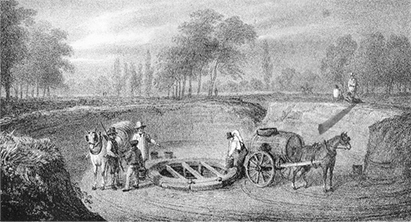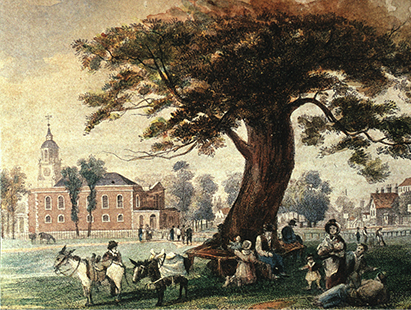Clapham Common was once the waste land of the Manors of Clapham and Battersea. Here the villagers grazed their livestock and gathered brushwood for their fires, while the ponds supplied good drinking water. Rights over the western half were claimed by both the parishes of Clapham and Battersea, and in the 17th century, the parishes contested ownership with fisticuffs and lawsuits. The disputed boundary, running north to south across the Common, is the modern boundary between the Boroughs of Lambeth and Wandsworth.
The 17th and 18th centuries
By the late 17th century, the Common was being used for recreation, including horse racing and cricket. In the next century its gravel was exploited for road making. The many gravel pits became ponds, and on one of these the American statesman and scientist Benjamin Franklin experimented with the properties of oil on the surface of water. Big houses were built all round the Common; but it remained a rough place, frequented at night by robbers.

In the 1760s a wealthy local resident, Christopher Baldwin, led an initiative to improve the Common by levelling and filling ditches and planting trees. Before that, the topographer Daniel Lysons wrote, “it was little better than a morass”; now, the “the number and variety of trees … give it very much the appearance of a park”. In 1774-76, Holy Trinity Church was built on land taken from the Common, to replace the old Parish Church. Holy Trinity achieved fame as the Church of the Clapham Sect, the group of Christian philanthropists led by William Wilberforce, who in 1807 achieved the abolition of the transatlantic slave trade. More information here.
Around the Church trees were planted by James Cook, son of the great explorer, one of them being known as Captain Cook’s tree. Destroyed by lightning a century ago, it was replaced by the black poplar which stands near the big drinking fountain.
The Victorian era

During the first half of the 19th century, the Common was managed by a group of local trustees, who filled in ponds and continued to level and plant. Grazing still took place – there were sheep on the Common as late as the 1920s – but the Common was now established as a place of leisure for the people of a fast-growing and wealthy suburb. Elsewhere in London, Commons were at risk of sale to developers, and in the 1860s, new legislation allowed them to be purchased for the benefit of the public. In 1877, the Metropolitan Board of Works purchased Clapham Common from its Manorial owners, to be “free and uninclosed (sic) forever”.

The Board and its successor the London County Council (LCC) continued to make improvements. An avenue was laid out for horse riding, and in 1890 the London County Council responded to public demand by building the bandstand, one of the largest and best surviving Victorian bandstands in the country. At a Speakers’ Corner, preachers, politicians and cranks expounded their views. There were boats for hire on the ponds: boys swam there.
The 20th century
The World Wars had a major impact. In both, large parts of the Common were turned over to allotments, and in the First World War troops were trained in digging trenches. In the Second World War the site now used for big events housed an anti-aircraft battery, and elsewhere bomb shelters were dug, and prefabs built for people who had lost their homes. Deep shelters were tunnelled under the Northern Line; in 1948, that at Clapham South famously became a temporary refuge for West Indian immigrants who had arrived on the SS Empire Windrush. There is a history of the deep shelters on the Clapham Society’s website.

After the War, the London County Council and its successor the Greater London Council (GLC) continued to provide sports facilities and entertainments. From 1954 to 1985, the Common was the venue for the international London Horse Show. By the 1990s, however, major tensions developed between some local residents and the Council over large scale concerts and other events, very popular, but seen by regular users of the Common as unsuited and damaging to a local recreational space.
Since 1971, the Common (including the Wandsworth half) has been owned in its entirety and managed by the London Borough of Lambeth.
For more information visit claphamsociety.com
